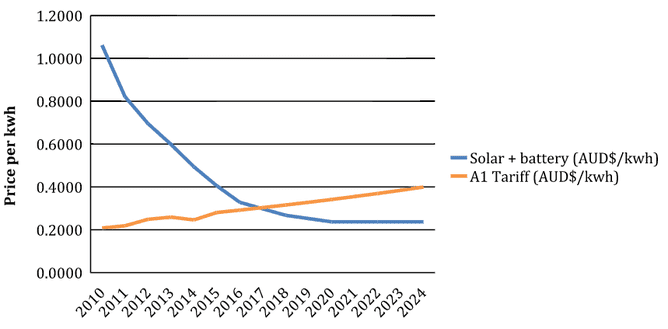Jemma Green, Curtin University; Josh Byrne, Curtin University, and Peter Newman, Curtin University
In his media conference immediately after winning the Liberal leadership, Malcolm Turnbull had some words to say on the subject of technology:
We have to recognise that the disruption that we see driven by technology, the volatility in change is our friend if we are agile and smart enough to take advantage of it.
In his previous job as communications minister, Turnbull would have been very familiar with the Internet’s capacity as a “disruptive†technology – one with the power to disrupt existing business models and render them obsolete. But it is in the power sector where the most disruptive potential is arguably now to be found.
While predecessor Tony Abbott placed his faith in fossil fuels and expressed a distaste for renewables, Australia has been quietly but dramatically embracing solar energy. Our research suggests a strong future for disruptive green innovations that are being developed faster here than elsewhere, offering a new industrial option as the resources boom tails off.
Solar rises in the west
Its always hard to know when innovation is going to be disruptive when it is happening around you. But from our research on green innovation here in Perth, we think the chances are high that we are in the midst of some disruptive green innovations that will be globally significant.
The key to this is the remarkable adoption of solar energy. In just a few years more than 190,000 Perth households have put solar panels on their rooftops – that is one in five homes or 490 megawatts of power, making these rooftops effectively the city’s biggest power station. Nationally, more than 1.4 million households now have solar panels. Few places in the world have adopted solar energy at such a rate.
But the uptake in solar power is set to receive another burst of acceleration, as the combination of solar panels with storage batteries becomes cost-effective and enters the mainstream.
As the chart below shows, solar cells, combined with lithium ion phosphate battery storage is about to become cheaper than the standard residential tariff for electricity customers on Western Australia’s main energy network.

Electricity tariffs are on the rise in Western Australia, while the cost of solar and storage drops sharply.
Green and Newman, Author provided
This means that we are likely to see more and more households and businesses switching to renewable energy. This is happening particularly quickly in Perth and also nationally, with Morgan Stanley predicting that 2.4 million houses on the National Electricity Market (NEM) will install batteries by 2030.
Such is the pace of development in Perth that the city could become a global centre for such green innovation, largely because:
- Perth has some 300 days a year without clouds, providing double the solar radiance of places like Germany. In a fossil-fuel free future, this will be a major resource.
- Retail electricity is more expensive here than in many places, such as the United States and Europe. This means that the point at which solar-battery storage becomes viable will arrive sooner. Western Australia’s proximity to China, where the solar panels and battery systems are made, also makes them cheaper to import.
Double the savings
According to our trials, while a 3-kilowatt solar photovoltaic system provides a 45% reduction in the household power bill (although generating twice the amount of power consumed), when combined with battery storage this figure can climb to 97%, while still providing surplus energy to the grid for most of the year.
New strata housing developments are being designed with shared solar-storage systems, cutting power bills for all residents.
Solar-storage systems can also help transform transport, as electric vehicles will no longer need to be charged only in daylight hours. Similar systems could even be used to power zero-carbon light rail, featuring battery-driven trams that can be recharged at stations through an induction system in the track. Solar panels and batteries can be built into stations and the surrounding high-density buildings, so that no other power is needed.
Australia’s sunshine has always been a major attraction for living here. With this disruptive new solar-storage technology, we have an opportunity to make the sun an even greater asset than it already is. Rather than continue to protect vested interests, this is exactly the kind of disruption our new prime minister should be making friends with.
![]()
Jemma Green, Research Fellow, Curtin University; Josh Byrne, Research Fellow, Curtin University Sustainability Policy Institute, Curtin University, and Peter Newman, Professor of Sustainability, Curtin University
This article was originally published on The Conversation. Read the original article.









